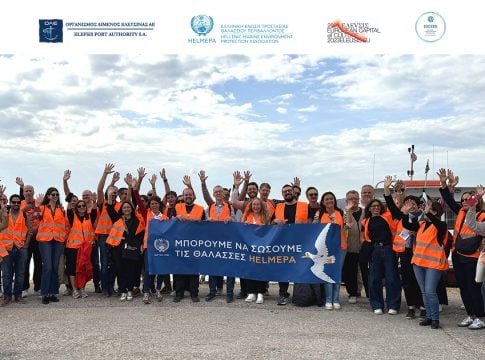General Director EFPIA (European Federation of Pharmaceutical Industries and Associations, Belgium) Natalie Moll, speaking to “N”, explains the problems that the new pharmaceutical legislation will bring to all member states and submits the EFPIA’s proposals for a better business future for the pharmaceutical industry that will also be supportive for patients.
On the occasion of the new pharmaceutical legislation being promoted by the European Commission I would like you to tell us what this will bring to business across Europe. What problems it will create for businesses across Europe, in Research and Innovation?
EFPIA supports the initial aims of the pharmaceutical strategy for Europe, of which the new legislation is a part, to be a world leader in innovation and create faster, more equitable access for patients across Europe. However, the net impact of the General Pharma Legislation’s proposals hampers innovation and heavily undermines the competitiveness of an industry that contributes more to the EU’s trade balance than any other sector.
While the Commission has committed to carrying out a European competitiveness check on future legislation it has not done so for the pharmaceutical legislation. Considering its impact on one of Europe’s largest and most strategically significant industries, EFPIA commissioned the Dolon consultancy to undertake a comprehensive competitiveness check on the proposed legislation.
The research analyses the impact of the Commission’s proposals across a number of areas, including EU innovation, competitiveness, impact on small and medium-sized enterprises (SMEs), patient access and environmental links.
The research shows that the Commission’s plans would hasten a trend which has seen Europe’s position as a global innovator deteriorate further in comparison to leading nations, the USA, China and Japan.
The data shows that the Commission’s proposals to reduce regulatory data protection (a vital component of intellectual property, for a large number of breakthrough medicines) reduces the incentive for companies to invest in these medicines by 55% in Europe over the next 15 years. This translates into a significant impact on European innovation and competitiveness.
The Commission proposals as published would escalate a trend which has already seen Europe lose a quarter of its global R&D investment in the last 20 years. The findings show:
- Europe’s R&D investment would reduce by a further third (32% to 21%) by 2040
- Europe would lose €2 billion investment annually
- One in five (22%) projects to research and develop RDP reliant medicines would no longer be economically viable in Europe.
- Europe would lose out on the research and development of about 50 of 225 expected new treatments over the next 15 years – medicines which may not be researched elsewhere.
- It represents an 8% drop in Europe’s total pharma innovation.
- Europe could see 16 million years of life lost (YLL) through increased mortality and premature death as a consequence of this lost innovation or become reliant on other nations for new research.
- Only one in ten SME-developed medicines that rely on RDP would be economically viable.
- The loss of 45 new treatments for rare diseases which may not be carried out elsewhere, with 4.5 billion Euros of research foregone in Europe.
- Unless significant changes are made in the ongoing legislative process, the revised legislation would further accelerate the loss of Europe’s industrial base, research and development (R&D), investment, jobs and growth, to the U.S. and Asia, while reducing access for European patients to cutting-edge science and innovative treatments.
MEPs and national governments now working on the General Pharmaceutical Legislation need to decide whether medical innovation should play a major role in Europe’s future. If it is to play a central role, the policies enacted now should be ambitious, coherent if they are to ensure Europe remains attractive for global investment.
In the midst of a pandemic, the need to return production to European territories became clear. The new legislation will prevent companies from making such a move?
EFPIA shares the objectives set out in the Commission’s Communication on addressing medicine shortages in the EU. Shortages cause harm to patients and immense concern to their families and clinicians. Although only 4% of shortages occur in the innovative medicines sector, recognising their impact, we are fully committed to working together to manage, mitigate and eradicate them where possible.
EFPIA particularly welcomes the structural measures to address the industrial dimension of medicines shortages in the medium and long term. In this respect, we applaud the Critical Medicines Alliance which should provide a genuine platform for national authorities, industry, civil society, the Commission and EU agencies to develop coordinated action against shortages and provide structural solutions rather than treating symptoms.
Shortages can arise for many different reasons such as manufacturing issues or a lack of capacity associated with long investment lead times. They can result from stronger and/or unexpected demand due to public health emergencies or poor forecasting. Solutions need to be fit for purpose targeting the specific root causes of shortages. Any measures aimed at mitigating shortages in the immediate and short term should be proportionate and provide efficient, workable solutions that serve public health needs.
For example, in a period of supply constraints imposing stockpiling obligations in some EU countries will simply translate into more shortage in others. It would go against the spirit of the EU voluntary solidarity mechanism foreseen to alleviate acute shortages.
Similarly, the European Commission draft General Pharmaceutical legislative proposal asking for prevention plans for all medicines or 6 months notification of shortages would divert limited resources (from both authorities and industry) from where they are needed and could lead to unintended consequences such as panic buying while at the same time might not help to address the real issues.
To fully deliver the actions included in the Communication, EU Institutions and Competent Authorities need to include industry in the design and implementation of new processes as well as share information on the likely demand for medicines as early as possible.
The failure to utilise the information stored in the European Medicines Verification System (EMVS) remains a missed opportunity to mitigate and manage shortages that could be readily implemented. The system provides real time data on the quantities of individual medicines in the supply chain at Member State level, even down to the exact number of boxes dispensed in national pharmacies and hospitals or the number of boxes of individual medicines that have been exported or imported. The data provides the most complete picture of the root causes of shortages, where and how shortages occur in Europe, and is our best chance to pre-empt, plan and mitigate their impact on patients. Not including this powerful resource in the Commission’s series of actions leaves a gaping hole in our collective efforts to protect patients from shortages of medicines across Europe.
How is the EU boosting support for innovation in the health sector?
Together with the European Commission, EFPIA has been a founding member of the Innovative Medicines Initiative (IMI) and pioneered public-private partnerships in health since 2008.
Europe needs strong infrastructure for medicines development that deliver evidence of regulatory quality. In IMI netoworks were created for paediatric trials and trials on antibiotics, and other infrastructures such as European Lead Factory (high quality compoind library and screening centre) and European Health Data Network (distributed network of data in 200 hospitals across Europe). These are essential tools to boost research and health delivery.
Public and private partners put their brains and assets together to modernise preclinical safety work. There was a lot of spotlights already on success stories such as vaccines and diagnostics on Ebola, or the development of the first ever human pancreatic beta-cell line.
Less is known about the many IMI projects that helped better understanding of diseases like autism, or enable better management of depression, COPD, asthma, obesity, diabetes or TB.
IMI consortia also looked after safety of medicines in pregnancy and breastfeeding and aim to shorten the path to diagnosis for those suffering from rare diseases.
Conscious that future breakthroughs in healthcare will be driven by big data, medical devices and digital tools, IMI needed to evolve. Exactly two years ago we launched the Innovative Medicines Initiative (IHI), a new European public-private partnership in health bringing together diverse technologies from across the life-science industry (IHI industry partners are COCIR, EFPIA, EuropaBio, MedTech Europe and Vaccines Europe. To discover more, visit www.ihi.europa.eu) as well as the public sector, academia, SMEs and patients.
IHI is has launched its first projects including cutting-edge research to replace animal testing, enhance personalised care and improve diagnostic tools for cancer and diabetes, among others.
EFPIA has committed more than 3 billion Euros across three programmes as we believe that partnerships such as IMI / IHI are the place to think of new solutions for patients, society, and a thriving environment for industry and innovation in Europe.
On the legislation
While EFPIA also supports the policies within the revision of the general pharmaceutical legislation which attempt to future-proof the regulatory framework. The plans to try and strengthen antimicrobial R&D is also supported by the industry. However, these are outweighed by concerns regarding the reduction of the current regulatory data protection (RDP) baseline, the inclusion of conditionalities to RDP, and the disproportionate proposals concerning shortages management and environmental requirements.
Orphan medicines: How the draft pharmaceutical legislation proposals would impact rare disease patients, since drugs for Rare Diseases are of smaller production and range than the rest?
The EU Orphan Medicinal Products (OMP) Regulation has been an undoubted success. It has had a significant impact on the area of rare diseases. It has stimulated the development of new treatments for patients living with previously untreatable rare conditions. It has been the main driver for great innovation and a genuine example of EU added value.
The OMP Regulation has resulted in more than 2,700 new orphan designations since 2000, which in turn led to more than 230 authorised new treatments for around 90 rare diseases between 2000 and 2018, compared to only 8 prior to the Regulation – an average of 9 new medicines per year.
Robust and reliable incentives remain essential, as the economic case for investment in rare diseases is only marginal. Therefore, if the EU seeks to be an attractive location for R&D investment, attracting the development of novel medicines and cutting-edge clinical trial participation for its patients, it must take the opportunity of the revision of its general pharmaceutical legislation for the first time in 20 years to strengthen the current baseline of incentives. In addition, there may be further potential to boost the orphan incentive system to encourage further investment in certain underserved areas where R&D is especially challenging. EFPIA supports a simple and predictable system of orphan incentives with a strengthened market exclusivity baseline, and modulation that takes into account the specific challenges related to development of treatment options for certain conditions.
The pharmaceutical industry expresses concern that the draft general pharmaceutical legislation as published by the EC would have a negative effect on research and development. This is especially true in the field of rare diseases. EFPIA analysed this in a study supported by Dolon recently published. We build on a risk-adjusted net present value model previously developed to assess the potential impact on innovation of regulatory changes put forward by the European Commission. The study shows that changes proposed by the Commission’s draft Pharmaceutical Legislation published in April 2023 would hamper the development of 45 products in Europe in 2020-2035 (resulting in a 12% decrease in innovation).5 million rare
Are new medicines affordable for all countries and health systems?
EFPIA has taken concrete steps as well as made concrete proposals to improve patient access to innovative medicines and reduce inequalities across Europe, taking into account health systems ability to pay for new medicines.
- In April 2022, EFPIA members committed to file pricing and reimbursement applications in all EU countries no later than 2 years after EU market authorisation.
- In parallel, a European Access Portal was set up where those same marketing authorisation holders should provide timely information regarding the timing and processing of the above-mentioned commitment and therefore of the pricing and reimbursement (P&R) applications in the various EU-27 countries, including the reasons why there is a delay in the P&R decision or why the MAH has not filed in a particular market.
- Industry also put forward a conceptual framework for Equity-Based Tiered Pricing (EBTP), to ensure that ability to pay across countries is considered in the prices of innovative medicines, anchored in a principle of solidarity between countries, to reduce unavailability of new medicines and access delays.
- Companies are already and regularly implementing novel payment and pricing models, when used appropriately and tailored to the situation, can accelerate patient access, allowing payers to manage clinical uncertainty, budget impact and sustainability of the healthcare system, whilst providing sufficient incentives for innovation.
- Industry continues to actively support and work towards achieving an efficient system of European assessments of relative efficacy at time of launch in the context of the implementation of the Health Technology Assessment (HTA) Regulation.
How to improve the attractiveness of the vaccine industry in the European Union?
Vaccination is one of the most successful health prevention tools, protecting against several infectious diseases. It has allowed us to eradicate smallpox, eliminate polio from nearly every region of the world and control diseases like measles, rubella and pertussis, among many others. Vaccination brings significant value not only to public health but to the economy as well, and should be viewed as an investment, rather than a cost. To take full advantage of the benefits that vaccination brings, we need the right environment to encourage vaccine innovation. However, findings from a recent report, highlight several challenges faced by the vaccine industry in Europe across the value chain.
The EU has been a leader in vaccine research, development and manufacturing, hosting approximately 22% of global vaccine clinical trials over the past two decades as well as research facilities affiliated with the world’s largest vaccine companies. The COVID-19 pandemic further cemented the EU’s footprint as a leader in the vaccine ecosystem when by January 2022, the EU had contributed to nearly 40% of the world’s COVID-19 vaccine exports. However, the vaccines industry in the EU is also grappling with many challenges. Limited funding, incentives and support for diverse vaccine types and platforms are barriers to early-stage vaccine research. Further, complex clinical trial requirements and lengthy timelines have contributed to a 35% relative decline in the share of global vaccine clinical trials conducted in the region since 2000.
While access to vaccines and other health innovations is a Member State competence, the EU can play a supporting role in improving the landscape of uptake and equity. A key issue on this front is the significant disparities in reimbursement timelines across Member States. Data shows that in 30% of EU countries, it often takes over 6 years for a new vaccine to be reimbursed. This further supports the need for innovative primary prevention solutions and improved decision-making process at the Member State level.
All of these factors need to be addressed to foster vaccine innovation and improve the attractiveness of the EU for the vaccine industry. Therefore, Vaccines Europe is calling for:
- sufficient levels of funding and investment to sustainably support vaccine research
- appropriate infrastructure and skilled workforce for vaccine R&D, manufacturing and assessment
- greater coordination between the EU and Member States to enable streamlined and harmonized processes, providing more timely access to innovative vaccines
- ensuring the regulatory and access environment has the necessary flexibility to support the assessment of innovative vaccines
- greater accountability and EU-wide policy prioritisation of prevention and immunisation to support more equitable population access to vaccines
- consistent support from the EU for the European vaccine industry in global policy debates
The EU vaccines industry is a ready and willing partner in innovation. The opportunity is now to collaborate toward sustained leadership within the vaccine ecosystem.
I recently read that pharma lobby says EU ban on ‘forever chemicals’ would halt drug production. More than 600 essential medicines at risk with new EU chemical proposal. What is your opinion on this?
A proposed restriction on the use of poly fluorinated substances (PFAS) across the EEA could see the widespread shut down of medicines manufacturing, according to analysis by EFPIA.
EFPIA has submitted a sector response to the ECHA open consultation with the objective to provide scientific and technical evidence to justify derogations and prevent medicine shortages, by informing ECHA and the EU Commission of the potential impact of the PFAS restriction on medicinal product supply chains.
In the consultation response, a patient impact analysis showed that if the proposals go ahead in their current form, they will lead to:
- At least 47,677 global marketing authorisations being affected if the proposed restriction is implemented, with a significant number of critical medicines no longer available, impacting patient access to medicines.
- More than 600 medicines from the WHO Essential Medicines List covering a variety of pharmacological/therapeutic groups are at risk.
- A particularly heavy impact across the European Member State’s “Critical Medicines lists” developed to counter shortages and to reduce Europe’s health dependence on non-European countries. For example, 78% of the critical medicines list in Norway could be impacted by the proposed restriction, in Finland 74%, Sweden 73%, France 72% and Germany 60%.
While we support the need to restrict certain PFAS, we need to find the right approach to ensure the continued manufacturing and availability of medicines in Europe. A total ban would see medicines’ manufacturing in the EU grind to a halt in under three years. It would also jeopardise the production of all pharmaceutical substances in Europe and would be in conflict with the EU’s strategy of reducing dependency on nations outside of the EEA in the event of shortages or pandemics.















